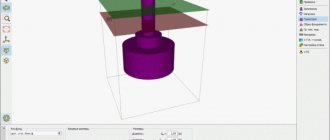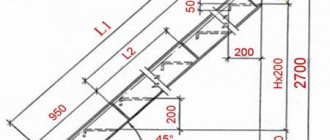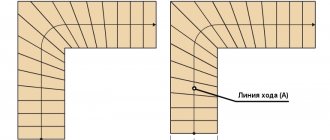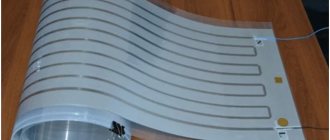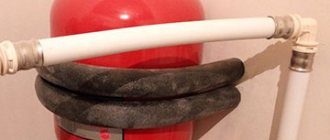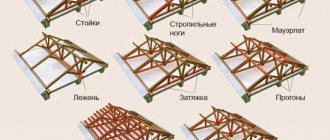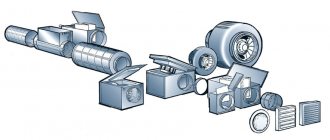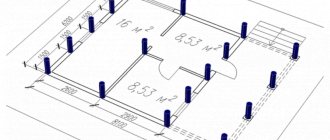To ensure comfortable living in the cold season, even at the stage of designing a private house, you need to take care of the calculation and installation of heating. Correctly performed thermal calculations will allow you to determine the optimal and cost-effective heating system. Any error can lead to you freezing or the building becoming hot and stuffy.
Independent calculations will not be a problem for people with technical education. However, not everyone has physical and mathematical skills, so an online calculator will be a good guide to calculations. It will help identify heat losses at home and calculate the power that the boiler should have. It will also determine the number of radiators needed and how many sections it should have. It will calculate heating costs for you, which will be useful for choosing a suitable heat source. Collect the necessary data for the calculation.
Determine heat losses. To do this, you need to know what material the external walls and floor coverings are made of, how they are insulated and their thickness. Measure the area of the house, windows and exterior doors. High intensity of heat loss from ventilation and sewerage. They also need to be taken into account in the calculations.
The climatic conditions of the location of the house play an important role in the choice of heating system. Find out the average annual and minimum temperatures in your area, as well as the average wind speed.
What factors are taken into account in the calculations?
The temperature in the house decreases due to the penetration of cold through the walls, floor, ceiling, windows and doors, as well as the entry of cold air through ventilation ducts.
The power of the gas boiler must compensate for all heat loss and maintain a constant set temperature in all residential premises. When making calculations, the following factors must be taken into account:
- The area of floors (floor and ceiling), fences (walls), roofing and glazing.
- Thermal conductivity and thickness of the materials used to construct the building. In this case, facing and finishing materials are taken into account. Tables of coefficients are easy to find on the Internet or specialized reference books; this value is calculated in W/(m*C°).
- The minimum temperature in this region during the cold season.
- The average temperature in the room, ensuring the comfort of people living in the building.
Consultants at heating equipment stores often recommend calculating the power of a gas boiler based on the following ratio: 40 W per cubic meter of volume or 1 kW per 10 m² with a standard room height of 2.5-2.6 meters. However, such calculations are quite approximate and as a result, the purchased equipment has a power reserve of 10-25%, depending on the situation, which affects its price and installation method.
When calculating heating power, you need to take into account that when ventilating, heat loss can reach 15%, low thermal resistance of walls will lead to a loss of another 35%, uninsulated and low-quality windows and doors - 10-15%, floors - 15%, and roofs - up to 25%. .
Types of batteries
There are several types of batteries, and we will list the characteristics of each to make it easier for you to choose the right option.
Steel
Not the most common option. The reason for their low popularity is their heat transfer characteristics. Advantages: reasonable price, light weight and easy installation. However, the walls have insufficient heat capacity - they quickly warm up and cool down quickly. In addition, water hammer can cause leaks in the places where the sheets are connected. At the same time, inexpensive models (without a protective coating) may rust. Such options last much less than others and their warranty period is more limited.
It is often difficult to determine the number of steel radiators for one room, since their solid design does not allow adding or removing sections. Thermal power must first be taken into account. It all depends on the width and length of the space in which you are going to install them. Some tubular models allow you to add segments. The craftsmen do it to order when they make them.
Cast iron
Each of us has seen such products: standard accordions. Even though their design was extremely simple, the design made it possible to effectively heat houses and apartments. The heat output of one accordion is 160 W. The calculation of sections of prefabricated cast iron radiators is simple, since their number could be unlimited. Modern proposals have become improved; they fit into different interiors. There are also exclusive models with relief patterns. Advantages of cast iron pipes:
- heat is retained for a long time at high output;
- resistance to water hammer and sudden temperature changes;
- Corrosion resistant.
You can use different coolants, as they are suitable for autonomous and central heating systems. Disadvantages include the fragility of the material (it cannot withstand direct impacts), the complexity of installation (due to its large size). In addition, not every wall will support their weight. Before starting the boiler in winter, test the system, fill the pipes with water to determine if there are any problems.
Aluminum
They appeared not so long ago, but quickly became popular. They are relatively inexpensive, minimalistically designed, and their material has good heat transfer. Aluminum models can withstand high pressure and temperature. The heat output of each section is up to 200 W, but at the same time its weight is small - no more than 2 kg. They do not require large coolants. They are stackable, so you can add or remove radiator sections based on the area of the room. There are also solid models.
Flaws:
- Aluminum is susceptible to corrosion. There is also a high probability of gas formation, so aluminum pipes are more suitable for an autonomous heating system.
- Non-separable models may leak at the joints; they cannot be repaired and will have to be completely replaced.
The most durable options are made from anodized metal. They remain resistant to corrosion for a long time
Their designs are roughly similar, and when you make your choice, pay attention to the documents. How to correctly calculate the number of radiator sections per room according to the instructions.
Bimetallic
The bimetallic radiator model is no less reliable than the cast iron one. Good thermal output makes them better than aluminum ones. This is facilitated by the features of their design. One segment consists of steel manifolds. They are connected by a metal channel. Craftsmen assemble them using threaded couplings. Due to the aluminum coating, good thermal output can be obtained. Pipes do not rust. High strength and wear resistance are combined with excellent heat dissipation.
We take into account heat loss
Let us note that regardless of whether the power of an electric boiler, a gas boiler, a diesel boiler or a wood boiler is calculated, in any case, the operation of the heating system will be accompanied by heat losses:
- Ventilation of the premises is necessary, but if the windows are constantly open, the house will lose about 15% of energy.
- If the walls are poorly insulated, then 35% of the heat will be lost.
- 10% of the heat will escape through the window openings, and even more if the frames are old.
- If the floor is not insulated, then 15% of the heat will be transferred to the basement or ground.
- 25% of the heat will escape through the roof.
Before calculating the heating boiler, it should be taken into account that if at least one of these factors occurs, then this should be reflected in the calculations.
Heat loss at home
How much heat should the pipeline supply?
Let's take a closer look at the example of how much heat is usually supplied through pipes, and select the optimal pipeline diameters.
There is a house with an area of 250 sq. m., which is well insulated (as required by the SNiP standard), so it loses heat in the winter by 1 kW per 10 sq. m. To heat the entire house, 25 kW of energy is required (maximum power). For the first floor - 15 kW. For the second floor - 10 kW.
Our heating scheme is two-pipe. One pipe supplies hot coolant, and the other pipe cools it to the boiler. Radiators are connected in parallel between the pipes.
On each floor, the pipes branch into two wings with the same thermal power, for the first floor - 7.5 kW, for the second floor - 5 kW.
So, 25 kW comes from the boiler to the interfloor branch. Therefore, we will need main pipes with an internal diameter of at least 26.6 mm so that the speed does not exceed 0.6 m/s. A 40mm polypropylene pipe is suitable.
From the interfloor branching - along the first floor to the branching on the wings - 15 kW is supplied. Here, according to the table, for a speed of less than 0.6 m/s, a diameter of 21.2 mm is suitable, therefore, we use a pipe with an outer diameter of 32 mm.
7.5 kW goes to the wing of the 1st floor - an internal diameter of 16.6 mm is suitable, - polypropylene with an outer diameter of 25 mm.
Accordingly, we use a 32mm pipe on the second floor before branching, a 25mm pipe on the wing, and we also connect the radiators on the second floor with a 20mm pipe.
As you can see, it all comes down to a simple choice among the standard diameters of commercially available pipes. In small home systems, up to a dozen radiators, in dead-end distribution circuits, 25 mm polypropylene pipes are mainly used - “per wing”, 20 mm - “per device”. and 32 mm “to the main line from the boiler”.
How to calculate the power of a gas boiler: 3 schemes of varying complexity
How to calculate the power of a gas boiler for the given parameters of a heated room? I know of at least three different methods that give different levels of reliability of the results, and today we will get acquainted with each of them.
The construction of a gas boiler house begins with the calculation of heating equipment.
general information
Why do we calculate parameters specifically for gas heating?
The fact is that gas is the most economical (and, accordingly, the most popular) source of heat. A kilowatt-hour of thermal energy obtained during its combustion costs the consumer 50-70 kopecks.
For comparison, the price of a kilowatt-hour of heat for other energy sources:
In addition to being economical, gas equipment is attractive due to its ease of use. The boiler requires maintenance no more than once a year, does not require kindling, cleaning the ash pan and replenishing the fuel supply. Devices with electronic ignition work with remote thermostats and are able to automatically maintain a constant temperature in the house, regardless of the weather.
A main gas boiler equipped with electronic ignition combines maximum efficiency with ease of use.
Does the calculation of a gas boiler for a home differ from the calculation of a solid fuel, liquid fuel or electric boiler?
In general, no. Any heat source must compensate for heat loss through the floor, walls, windows and ceiling of the building. Its thermal power is in no way related to the energy carrier used.
In the case of a double-circuit boiler that supplies the house with hot water for household needs, we need a power reserve to heat it. Excess power will ensure simultaneous water consumption in the hot water system and heating of the heating medium.
Calculation methods
Scheme 1: by area
How to calculate the required power of a gas boiler based on the area of the house?
Regulatory documentation dating back half a century will help us with this. According to Soviet SNiP, heating should be designed at the rate of 100 watts of heat per square meter of heated space.
Estimation of heating power by area. 100 watts of boiler and heating power are allocated per square meter.
Let's, as an example, calculate the power for a house measuring 6x8 meters:
- The area of a house is equal to the product of its overall dimensions. 6x8x48 m2;
- With a specific power of 100 W/m2, the total boiler power should be equal to 48x100=4800 watts, or 4.8 kW.
Choosing the boiler power according to the area of the heated room is simple, understandable and... in most cases gives the wrong result.
Because he neglects a number of important factors that influence real heat loss:
- Number of windows and doors. More heat is lost through glazing and doorways than through a solid wall;
- Ceiling height. In Soviet-built apartment buildings it was standard - 2.5 meters with a minimum error. But in modern cottages you can find ceilings 3, 4 or more meters high. The higher the ceiling, the larger the heated volume;
The photo shows the first floor of my house. Ceiling height 3.2 meters.
Climatic zone. With the same quality of thermal insulation, heat loss is directly proportional to the difference between indoor and outdoor temperatures.
In an apartment building, heat loss is affected by the location of the living space relative to the external walls: end and corner rooms lose more heat. However, in a typical cottage, all rooms have common walls with the street, so the corresponding correction factor is included in the basic value of thermal power.
Corner room in an apartment in an apartment building. Increased heat loss through external walls is compensated by installing a second battery.
Scheme 2: by volume, taking into account additional factors
How to calculate a gas boiler for heating a private house with your own hands, taking into account all the factors I mentioned?
First and foremost: in the calculation we take into account not the area of the house, but its volume, that is, the product of the area and the height of the ceilings.
- The basic value of boiler power per cubic meter of heated volume is 60 watts;
- The window increases heat loss by 100 watts;
- The door adds 200 W;
- Heat loss is multiplied by a regional coefficient. It is determined by the average temperature of the coldest month:
System installation
First of all, we need to install sectional radiators. They must be placed strictly under the windows; warm air from the radiator will prevent the penetration of cold air from the window. To install sectional radiators, you do not need any special equipment, just a hammer drill and a building level. It is necessary to strictly adhere to one rule: all radiators in the house must be mounted strictly on the same horizontal level; the overall circulation of water in the system depends on this parameter. Also ensure that the radiator fins are vertical.
After installing the radiators, you can begin laying pipes. It is necessary to measure the total length of the pipes in advance, and also count the number of various fittings (elbows, tees, plugs, etc.). To install plastic pipes you will need only three tools - a tape measure, pipe scissors and a soldering iron. Most of these pipes and fittings have laser perforations in the form of notches and guide lines, which makes it possible to carry out installation correctly and evenly on site. When working with a soldering iron, you should adhere to only one rule - after you have melted and joined the ends of the products, under no circumstances twist them if you did not manage to solder smoothly the first time, otherwise a leak may occur in this place. It’s better to practice in advance on pieces that will go to waste.
Calculation taking into account the area of the room
How to include information about ceiling height or climate in this formula? This has already been taken care of by specialists who have empirically derived coefficients that allow certain adjustments to be made to the calculations.
So, the above norm is 1 kW per 10 sq. meters - implies a ceiling height of 2.7 meters. For higher ceilings, it will be necessary to calculate the correction factor and recalculate. To do this, the ceiling height must be divided by the standard 2.7 meters.
We propose to consider a specific example: the ceiling height is 3.2 meters. The calculation of the coefficient looks like this: 3.2/2.7=1.18. This figure can be rounded to 1.2. How to use the resulting figure? Let us remind you that for heating a room of 160 sq. meters you need 16 kW of power. This indicator must be multiplied by a factor of 1.2. The result is 19.2 kW (rounded to 20 kW).
Next, we should add climatic features. For Russia, certain coefficients apply depending on the location:
- in the northern regions 1.5–2.0;
- in the Moscow region 1.2–1.5;
- in the middle zone 1.0–1.2;
- in the south 0.7–0.9.
However, that's not all. The above values can be considered correct if a factory or home-made boiler will work exclusively for heating. Let's assume that you want to assign water heating functions to it. Then we add another 20% to the final figure. Take care of power reserves for peak temperatures in severe frosts, and this is another 10%.
You will be surprised by the results of these calculations. Let's give specific examples.
A house in central Russia with heating and hot water will require 28.8 kW (24 kW + 20%). In cold weather, another 10% of power is added 28.8 kW + 10% = 31.68 kW (rounded to 32 kW). As you can see, this last figure is 2 times higher than the original one.
Calculations for a house in the Stavropol region will be slightly different. If you add the power for water heating to the above indicators, you will get 19.2 kW (16 kW + 20%). And another 10% “reserve” for cold will give you a figure of 21.12 kW (19.2+10%). Round up to 22 kW. The difference is not so great, but, nevertheless, these indicators must be taken into account.
As you can see, when calculating the power of a heating boiler, it is very important to take into account at least one additional indicator
Please note that the formula regarding heating for an apartment and the same for a private house are different from each other. In principle, when calculating this indicator for an apartment, you can follow the same path, taking into account the coefficients reflecting each factor
However, there is an easier and faster way that will allow you to make adjustments in one go.
For apartments this figure will be different. If there is a heated room above your apartment, then the coefficient is 0.7, if you live on the top floor, but with a heated attic - 0.9, with an unheated attic - 1.0. How to apply this information? The boiler power, which you calculated using the above formula, must be adjusted using these coefficients. This way you will receive reliable information.
Before us are the parameters of an apartment located in a city in central Russia. To calculate the volume of the boiler, we need to know the area of the apartment (65 square meters) and the height of the ceilings (3 meters).
First step: determining the power by area - 65 m2/10 m2 = 6.5 kW.
Second step: adjustment for the region - 6.5 kW * 1.2 = 7.8 kW.
Third step: the gas boiler will be used to heat water (add 25%) 7.8 kW * 1.25 = 9.75 kW.
Fourth step: adjustment for extreme cold (add 10%) - 7.95 kW*1.1=10.725 kW.
The result must be rounded, and the result will be 11 kW.
To summarize, we note that these calculations will be equally correct for any heating boilers, regardless of what type of fuel you use. Exactly the same data is relevant for an electric heating device, a gas boiler, and one that runs on liquid energy. The most important thing is the efficiency and performance of the device. Heat loss does not depend on its type.
We focus on the volume of housing - we use SNiP standards
When calculating heating equipment for apartments, you can focus on SNiP standards. Building codes and regulations determine how much thermal energy is needed to heat 1 m3 of air in standard buildings. This method is called calculation by volume. SNiP provides the following standards for thermal energy consumption: for a panel house - 41 W, for a brick house - 34 W. The calculation is simple: we multiply the volume of the apartment by the rate of heat energy consumption.
Heating system
Here's an example. An apartment in a brick house with an area of 96 sq.m., ceiling height - 2.7 m. Let's find out the volume - 96 × 2.7 = 259.2 m3. Multiply by the norm - 259.2 × 34 = 8812.8 W. Converting to kilowatts, we get 8.8. For a panel house, we carry out the calculations in a similar way - 259.2×41 = 10672.2 W or 10.6 kilowatts. In heating engineering, rounding is carried out upward, but if you take into account energy-saving packages on windows, you can round down.
The obtained data on equipment power are initial. For a more accurate result, correction will be needed, but for apartments it is carried out according to different parameters. The first step is to take into account the presence of an unheated room or its absence:
- if a heated apartment is located on the floor above or below, we apply an amendment of 0.7;
- if such an apartment is not heated, we do not change anything;
- if there is a basement under the apartment or an attic above it, the correction is 0.9.
We also take into account the number of external walls in the apartment. If one wall faces the street, we apply an amendment of 1.1, two - 1.2, three - 1.3. The method for calculating boiler power by volume can also be applied to private brick houses.
So, you can calculate the required power of a heating boiler in two ways: by total area and by volume. In principle, the data obtained can be used if the house is average, multiplying it by 1.5. But if there are significant deviations from the average parameters in the climate zone, ceiling height, insulation, it is better to correct the data, because the initial result may differ significantly from the final one.
Method number 1 is the simplest
Using this method, you need to calculate the heated area, divide it by ten (based on the well-known formula - 0.1 kW of heat is needed to heat 1 m2). And then multiply by 1.5, that is, this coefficient takes into account heat losses through windows, walls, doors, floors, roofs, northern location of windows, non-density structures, etc.
This method is good for those who are not used to saving. Who cares whether to buy a boiler with a capacity of 50 or 100 kW. But for the majority of the population it is not suitable. In most cases, this calculation results in an unreasonably high required boiler power. And this is the main factor influencing its price. In addition, due to significant overpowering, the automation will turn off the equipment too often, which negatively affects its service life. The same can be said about a boiler model that operates at the limit of its capabilities.
Valtec “Sputnik” equipment configurator
Configurator software is a modular configurator for various metering devices and equipment. Allows commissioning of the Valtec “Sputnik” automated energy metering system.
- The configurator includes the following modules:
- polling of metering devices via radio channel using radio modem VT.WRM.MASTER.0
- module for reading data from VT.WRM hubs
- module for configuring wireless pulse counter-recorder GSM/GPRS VT.WLR.GSM
- module for configuring a wireless pulse counter-recorder with a radio channel (LoRAWAN 868 MHz) VT.LR
- module for configuring pulse counter-recorder SIPU (RS485/M-Bus) VT.MB/ VT.RS
Concept of dispersion coefficient
The dissipation coefficient is one of the important indicators of heat exchange between a living space and the environment. Depending on how well the house is insulated. There are indicators that are used in the most accurate calculation formula:
- 3.0 – 4.0 is the dissipation coefficient for structures that do not have any thermal insulation at all. Most often in such cases we are talking about temporary structures made of corrugated iron or wood.
- A coefficient of 2.9 to 2.0 is typical for buildings with a low level of thermal insulation. This refers to houses with thin walls (for example, one brick) without insulation, with ordinary wooden frames and a simple roof.
- An average level of thermal insulation and a coefficient of 1.9 to 1.0 are assigned to houses with double plastic windows, insulation of external walls or double masonry, as well as with an insulated roof or attic.
- The lowest dispersion coefficient from 0.6 to 0.9 is typical for houses built using modern materials and technologies. In such houses, the walls, roof and floor are insulated, good windows are installed and the ventilation system is well thought out.
Table for calculating the cost of heating in a private house
The formula that uses the value of the dissipation coefficient is one of the most accurate and allows you to calculate the heat loss of a particular structure. It looks like this:
In the formula, Qt is the level of heat loss, V is the volume of the room (the product of length, width and height), Pt is the temperature difference (to calculate it is necessary to subtract from the desired temperature in the room the minimum air temperature that can be at this latitude), k is the dispersion coefficient.
Let's substitute the numbers into our formula and try to find out the heat loss of a house with a volume of 300 m³ (10 m*10 m*3 m) with an average level of thermal insulation at a desired air temperature of +20C° and a minimum winter temperature of -20C°.
Having this figure, we can find out what power boiler is needed for such a house. To do this, the resulting heat loss value should be multiplied by the safety factor, which is usually from 1.15 to 1.2 (the same 15-20%). We get that:
By rounding the resulting number down, we find out the required number. To heat a house under the conditions we have specified, you will need a 38 kW boiler.
This formula will allow you to very accurately determine the power of the gas boiler required for a particular home. Also today, many different calculators and programs have been developed that allow you to take into account the data of each individual building.
Do-it-yourself heating of a private house - tips on choosing the type of system and type of boiler Requirements for installing a gas boiler: what is necessary and useful to know about the connection procedure? How to correctly and without errors calculate heating radiators for a home Water supply system for a private house from a well: recommendations for creating
How heat-saving film is used for windows - pros and cons of use
In search of energy savings, consumers are looking for new building materials that will help save heat in their home or apartment. A special place in this series is occupied by heat-reflecting film for windows, which can reduce energy consumption by up to 30 percent.
How advisable is it to use this material and what properties, besides heat conservation, does the film have?
How to calculate the cost of heating a house with a boiler
To calculate the required equipment performance and costs, you need to understand the climate, area, volume of living space, degree of insulation and amount of heat loss
When using turbine devices for this, it is also necessary to take into account the amount of energy that is spent on heating the air. To determine the productivity and costs of the boiler, it is first necessary to calculate the heat losses
This is difficult to do, since you need to take into account a large number of components, in particular the materials for constructing walls, floors, roofing, and the like. You should also understand the type of heating wiring, the presence of heated floors and household appliances that produce heat.
To accurately calculate heat loss and heating costs, professionals use thermal imagers. Then they calculate the required indicator using complex formulas. Naturally, the average user will not understand the nuances of thermal technology. There are available methods for them that allow you to quickly and optimally calculate the optimal performance of equipment.
The most accessible way is to use the universal formula, where 10 square meters equals 1 kilowatt. In accordance with the pricing policy of the region, the cost of 1 cubic meter of gas costs about 4 rubles during the day, and 3 rubles at night. As a result, you will have to spend 6,300 rubles per 10 square meters for the heating season.
You can find out the optimal heater performance using a convenient calculator. In order to calculate everything correctly and get the final result, you will need to enter the total heating area. Next, you need to fill out information about what type of glazing, level of thermal insulation of walls, floors and ceilings is used. Additional parameters also take into account the height of the ceiling in the room and the introduction of information about the number of walls that interact with the street. They also take into account the fact how many floors there are in the building and whether there are structures on top of it. Only after this can you find out the current prices for 1 cubic meter and calculate everything.
Diameter selection
General information
Polypropylene pipes
Intermediate pipes between thermal elements (radiators, registers) are a kind of coolant line for heating systems, which must have sufficient throughput to ensure normal movement. That is, the normal operation of the system as a whole will depend entirely on how well this parameter is selected.
However, unlike a highway, where the principle “the wider the better” applies, the heating system needs optimal values, since the presence of pipes with a cross-section that is too large will be as undesirable as the use of a small diameter. An insufficiently large size will cause noise - due to increased circulation speed.
An excessively large diameter requires the presence of a large amount of coolant (in this case, water) in the system, which in turn will lead to large heat losses and uneven heating of the premises. In such cases, what usually happens is that the water heating radiators in the room that is closer to the boiler warm up quite well, while in the remaining rooms the temperature in the heating elements begins to drop sharply.
Stainless steel pipes
Also, an irrationally large cross-section causes a large amount of resources to be spent on maintaining the required temperature due to the increased amount of coolant. Accordingly, the smaller the size, the lower the cost of heating the room.
Selection formula
To calculate the diameter, you need to determine how much energy consumption will be required to heat a particular room. Initially, you need to calculate the square footage of the room - measure the length and width of the room, and then multiply both values together. Thus, as a result you will get the exact number of square meters.
To heat 10 square meters of area with a ceiling height of no more than 3 meters, 1 kW of energy will be required. Based on this standard, the total energy consumption of all rooms in the house is calculated.
Selecting the diameter of a copper heating pipe
That is, to heat a room of 40 square meters, you need 4 kW of energy + 20%. Through these calculations, the diameter of the heating pipes is selected based on the list provided below.
It also contains a designation of the optimal circulation speed, which should be no less than 0.2 and no more than 1.5 meters per second.
If the speed of water movement is less than 0.2 m/sec, this will lead to air jams and poor heating.
If it exceeds 1.5 m/sec, then there is a high probability of extraneous noise appearing, which is a consequence of the coolant passing through various obstacles:
- wiring,
- turns, etc.
The most optimal value is the range from 0.3 to 0.4 m/sec.
Radiator with two-pipe system
- For 3 - 5 kW it is more advisable to use 20 mm, the coolant speed will be 0.2 - 0.4 m/sec;
- For 6 - 9 kW, the optimal value is 25 mm, the value of the coolant speed in this case will be 0.3 - 0.4 m/sec;
- For 10 - 15 kW, it is advisable to use pipes with a cross section of 32 mm, in which the circulation will be 0.3 - 0.4 m/sec. It is acceptable to use pipes with a cross-section of 20 mm, but in this case the coolant speed will be from 0.5 to 0.7 m/sec;
- For 16 - 21 kW - the optimal value will be 40 mm, the value of the coolant movement speed in this case will be from 0.3 to 0.4 m/sec;
- For 22 - 32 kW, the best value will be 50 mm, the circulation speed in this case will be in the range of 0.3 - 0.4 m/sec;
Calculation by area
It is more accurate because it takes into account more factors. The calculation is made using the formula:
Q = 0.1*S*k1*k2*k3*k4*k5*k6*k7, where:
0.1 kW is the heat norm per 1 sq. m;
S – area of the heated house;
k1 demonstrates the heat loss caused by the window design. Has the meaning:
- 1.27 – if the windows have one glass;
- 1.0 – if there are double-glazed windows;
- 0.85 – if there are windows with triple glass.
k2 demonstrates the heat loss caused by the window area (Sw). Is the ratio of Sw to the floor area Sf. Its meanings are:
- 0.8 at Sw/Sf = 0.1;
- 0.9 at Sw/Sf = 0.2;
- 1 at Sw/Sf = 0.3;
- 1.1 at Sw/Sf = 0.4;
- 1.2 at Sw/Sf = 0.5.
k3 is the coefficient of heat loss through the walls. It happens like this:
- 1.27 with very poor thermal insulation;
- 1 in houses with a wall of 2 bricks or insulation, the thickness of which is 15 cm;
- 0.854 with good thermal insulation.
k4 shows heat loss depending on the air temperature outside the house (tz). Has the following meanings:
- 0.7, if tз = -10 °С;
- 0.9 for tз = -15 °С;
- 1.1 for tз = -20 °С;
- 1.3 for tз = -25 °С;
- 1.5 for tз = -30 °С.
k5 demonstrates heat loss through external walls. Is like this:
- 1.1 for rooms with one external wall;
- 1.2 for 2 external walls;
- 1.3 for 3 external walls;
- 1.4 for a building with 4 external walls.
K6 shows how much additional heat is required depending on the ceiling height (H). Its meanings are:
- 1 for H = 2.5 m;
- 1.05 for H = 3.0 m;
- 1.1 for H = 3.5 m;
- 1.15 for H = 4.0 m;
- 1.2 for H = 4.5 m.
k7 determines heat loss depending on the type of room located above the heated room. It happens like this:
- 0.8 for heated rooms;
- 0.9 for a warm attic;
- 1 for a cold attic.
Example. The conditions of the problem are the same. The windows are triple glazed and make up 30% of the floor area. The number of external walls is 4. There is a cold attic upstairs.
Q = 0.1*200*0.85*1*0.854*1.3*1.4*1.05*1 = 27.74 kW/h. This figure must be increased by adding with your own hands the amount of heat required for hot water supply.
Radiator calculations
In our case, we will use standard aluminum radiators with a height of 0.6 m. The power of each fin of such a radiator at a temperature of 70 ° C is 150 W. Next, we will calculate the power of each radiator and the number of conventional fins:
- room 1: 28 m3 · 40 W · 1.2 = 1344 W. We round up to 1500 and get 10 conventional fins, but since we have two radiators, both under the windows, we will take one with 6 fins, the second with 4.
- room 2: 28 m3 · 40 W · 1.2 = 1344 W. We round up to 1500 and get one radiator with 10 fins.
- room 3: 56 m3 · 40 W · 1.2 = 2688 W We round up to 2700 and get three radiators: 1st and 2nd with 5 fins each, 3rd (side) with 8 fins.
- hallway: 22.4 m3 · 40 W · 1.2 = 1075.2 W. We round up to 1200 and get two radiators with 4 fins each.
- bathroom: 11.2 m3 · 45 W · 1.2 = 600 W. Here the temperature should be a little higher, you get 1 radiator with 4 fins.
- toilet: 8.4 m3 · 40 W · 1.2 = 403.2 W. Round up to 450 and get three edges.
- kitchen: 43.4 m3 · 40 W · 1.2 = 2083.2 W. We round up to 2100 and get two radiators with 7 fins each.
As a final result, we see that we need 12 radiators with a total capacity:
- 900 + 600 + 1500 + 750 + 750 + 1200 + 600 + 600 + 600 + 450 + 1050 + 1050 = 10.05 kW
Based on the latest calculations, it is clear that our individual heating system can cope with the load placed on it without any problems.
Calculation of the number of sections of heating devices
The heating system will not be effective if the optimal number of radiator sections is not calculated. An incorrect calculation will lead to the rooms being heated unevenly, the boiler will work at the limit of its capabilities or, conversely, “idlely” wasting fuel.
Some home owners believe that the more batteries the better. However, this lengthens the path of the coolant, which gradually cools, which means that the last rooms in the system risk being left without heat. Forced coolant circulation partly solves this problem. But we must not lose sight of the power of the boiler, which may simply “not cope” with the system.
To calculate the number of sections, you will need the following values:
- the area of the heated room (plus the adjacent one, where there are no radiators);
- power of one radiator (indicated in the technical specifications);
take into account that per 1 sq. m
living space will require 100 W of power for central Russia (according to SNiP requirements).
The area of the room is multiplied by 100 and the resulting amount is divided by the power parameters of the installed radiator.
Example for a room of 25 square meters. meters and radiator power 120 W: (20x100)/185=10.8=11
This is the simplest formula; if the height of the rooms is not standard or their configuration is complex, other values are used.
How to correctly calculate heating in a private house if the power of the radiator is unknown for some reason? By default, the average static power is 200 W. You can take the average values of certain types of radiators. For bimetallic ones this figure is 185 W, for aluminum ones - 190 W. For cast iron, the value is much lower - 120 W.
If the calculation is carried out for corner rooms, then the result obtained can be safely multiplied by a factor of 1.2.
How to more correctly assess the degree of thermal insulation of the walls of a room?
As promised above, this section of the article will help the reader with assessing the level of thermal insulation of the walls of his residential properties. To do this, you will also have to carry out one simplified thermotechnical calculation.
Principle of calculation
According to the requirements of SNiP, the heat transfer resistance (which is also called thermal resistance) of building structures of residential buildings must not be lower than the standard value. And these standardized indicators are established for the regions of the country, in accordance with the characteristics of their climatic conditions.
Where can I find these values? Firstly, they are in special appendix tables to SNiP. Secondly, information about them can be obtained from any local construction or architectural design company. But it is quite possible to use the proposed map-scheme, covering the entire territory of the Russian Federation.
Diagram map for determining the normalized value of the thermal resistance of building structures
In this case, we are interested in the walls, so we take from the diagram the value of thermal resistance specifically “for walls” - they are indicated in purple numbers.
Now let's take a look at what this thermal resistance consists of, and what it is equal to from the point of view of physics.
So, the heat transfer resistance of some abstract homogeneous layer x is equal to:
Rх = hх / λх
Where:
Rx - heat transfer resistance, measured in m²×°K/W;
hx is the layer thickness, expressed in meters;
λx is the thermal conductivity coefficient of the material from which this layer is made, W/m×°K. This is a tabular value, and for any building or thermal insulation material it is easy to find on Internet reference resources.
Conventional building materials used for the construction of walls, most often, even with their large (within reason, of course) thickness, do not reach the standard indicators of heat transfer resistance. In other words, the wall cannot be called fully thermally insulated. This is precisely why insulation is used - an additional layer is created that “makes up for the deficit” necessary to achieve standardized indicators. And due to the fact that the thermal conductivity coefficients of high-quality insulation materials are low, you can avoid the need to build very thick structures.
You may be interested in information about what a hydraulic arrow is, how it works, its purpose and calculations
Let's take a look at a simplified diagram of an insulated wall:
Wall diagram with insulation layer and finishing
1 - in fact, the wall itself, which has a certain thickness and is built from one material or another. In most cases, “by default” it itself is not able to provide the normalized thermal resistance.
2 - a layer of insulating material, the thermal conductivity coefficient and thickness of which should ensure “covering the shortage” up to the normalized R value. Let’s make a reservation right away - the location of thermal insulation is shown on the outside, but it can also be placed on the inside of the wall, and even located between two layers of the supporting structure (for example , laid out of brick according to the “well masonry” principle).
3 - external facade finishing.
4 - interior decoration.
Finishing layers often do not have any significant effect on the overall thermal resistance rating. Although, when performing professional calculations, they are also taken into account. In addition, the finishing can be different - for example, warm plaster or cork slabs are very capable of enhancing the overall thermal insulation of the walls. So, for the “purity of the experiment,” it is quite possible to take both of these layers into account.
But there is also an important note - the façade finishing layer is never taken into account if there is a ventilated gap between it and the wall or insulation. And this is often practiced in ventilated facade systems. In this design, the external finishing will not have any effect on the overall level of thermal insulation.
So, if we know the material and thickness of the main wall itself, the material and thickness of the insulation and finishing layers, then using the above formula it is easy to calculate their total thermal resistance and compare it with the standardized indicator. If it is not less, there is no question, the wall has full thermal insulation. If it is not enough, you can calculate which layer and which insulating material can fill this deficiency.
You may be interested in information about how heating is calculated in a private house calculator
And to make the task even easier, below is an online calculator that will perform this calculation quickly and accurately.
Just a few explanations about working with it:
- To begin with, using the map diagram, find the normalized value of heat transfer resistance. In this case, as already mentioned, we are interested in the walls.
(However, the calculator is universal. And it allows you to evaluate the thermal insulation of both floors and roofing coverings. So, if necessary, you can use it - add the page to your bookmarks).
- The next group of fields indicates the thickness and material of the main supporting structure - the wall. The thickness of the wall, if it is built according to the “well masonry” principle with insulation inside, is indicated as the total thickness.
- If the wall has a thermal insulation layer (regardless of its location), then the type of insulation material and thickness are indicated. If there is no insulation, then the default thickness is left equal to “0” - move on to the next group of fields.
- And the next group is “dedicated” to the external decoration of the wall - the material and thickness of the layer are also indicated. If there is no finishing, or there is no need to take it into account, everything is left by default and moved on.
- The same applies to the interior wall decoration.
- Finally, all that remains is to choose the insulation material that you plan to use for additional thermal insulation. Possible options are indicated in the drop-down list.
After clicking on the “CALCULATE MISSING INSULATION THICKNESS” button, the result in millimeters will be shown. Here are the possible options:
— A zero or negative value immediately indicates that the thermal insulation of the walls meets the standards, and additional insulation is simply not required.
— A positive value close to zero, say, up to 10÷15 mm, also does not give much reason to worry, and the degree of thermal insulation can be considered high.
— Insufficiency of up to 70÷80 mm should already make the owners think. Although such insulation can be classified as average efficiency, and taken into account when calculating the thermal power of the boiler, it is still better to plan work to enhance thermal insulation. What thickness of the additional layer is needed is already shown. And the implementation of these works will immediately give a tangible effect - both by increasing the comfort of the microclimate in the premises and by reducing the consumption of energy resources.
— Well, if the calculation shows a shortage of more than 80÷100 mm, there is practically no insulation or it is extremely ineffective. There cannot be two opinions here - the prospect of carrying out insulation work comes to the fore. And this will be much more profitable than purchasing a boiler with increased power, part of which will simply be spent literally on “warming up the street.” Naturally, accompanied by ruinous bills for wasted energy.
You might find the heating diagram for a two-story house with forced circulation useful
Calculator for assessing the effectiveness of wall thermal insulation
Go to calculations
We will conclude the publication with a video, also dedicated to taking into account heat losses when calculating the power of a heating system. Compression fittings for metal-plastic pipes you will find the answer in the link.
Power calculation for DHW
It is carried out in the following sequence:
- The volume of warm water used by all family members is determined.
- The volume of hot water (90-95 °C) is determined, which will be diluted with running water to form a liquid that has a comfortable temperature for the body.
- The additional boiler power is calculated.
So, let a family live in a house that uses 150 liters of warm water per day, that is, liquid with a temperature of 37 °C. This water will be supplied after mixing hot and running water. The volume of hot water is determined by the formula:
- Vв is the volume of demanded warm water,
- Tzh - the desired temperature of warm water at the outlet of the tap,
- Tp is the temperature of running water,
- Tg is the temperature of the heated liquid in the indirect boiler.
For the above example, Vв = 150 l, Тп = 8 °С, Тж = 37 °С, Тг = 95 °С. Vg = 150*(37-8)/(95-8) = 50 l. This means that a 50 liter boiler is enough for a home.
The formula for determining additional power is:
where c is the specific heat capacity of water (always equal to 4.218 kJ/kg*K),
ΔT is the difference between the temperatures of heated and running water.
Рд = 4.218*50*(95-8) = 18,348.3 kJ. In terms of kW/h, this figure is 5.1 kW/h.
As you can see, to heat a house you need to purchase an electric heating boiler with a power of 20+5.1 = 25.1 kW/hour. This is the case if the water in the boiler must be heated in 1 hour. If it needs to be heated in 2, then you can install a boiler whose power is 20+2.55 = 22.55 kW/hour.
Power and number of sections of aluminum radiators Connecting an electric boiler to the heating system Manufacturing the Scorpion electric boiler Power of heating radiators
Expansion tank
You can determine what capacity the expansion tank should have by having data on the coefficient of thermal expansion of the coolant. For water this indicator is 0.034 when heated to 85 °C.
When performing the calculation, it is enough to use the formula: V-tank = (V system × K) / D, where:
- V-tank - the required volume of the expansion tank;
- V-syst - the total volume of liquid in the remaining elements of the heating system;
- K – expansion coefficient;
- D – efficiency of the expansion tank (indicated in the technical documentation).
Advantages and disadvantages of electric heating
The advantages include:
Diagram of operation of an electric boiler.
- environmental safety (no harmful fuel combustion waste);
- quiet operation;
- simple schemes for organizing automatic operation;
- there is no need for chimneys (when using a condensing gas boiler, a drain will also be required to remove condensate);
- ease of operation;
- Compared to a gas boiler, you will have to issue a significantly smaller number of permitting documents. In most cases, permission from Energonadzor is sufficient.
The silent operation of heating boilers and environmental friendliness allow them to be located directly in the room, which is facilitated by the absence of chimneys. Consequently, installation of an electric heating boiler, both floor and wall-mounted, is not difficult.
The disadvantages of this heating option include significantly higher heating costs compared to gas counterparts. The advantage of the condensing gas analogue is especially great. Therefore, electric heating is forced to be used in places where there is no centralized gas supply.
Eventually
As you can see, calculating the heating capacity comes down to calculating the total value of the four above elements.
Not everyone can determine the required capacity of the working fluid in a system with mathematical accuracy. Therefore, not wanting to perform the calculation, some users act as follows. To begin with, fill the system to approximately 90%, after which the functionality is checked. Next, the accumulated air is released and filling continues.
During operation of the heating system, a natural decline in the coolant level occurs as a result of convection processes.
In this case, there is a loss of power and productivity of the boiler. This implies the need to have a reserve tank with working fluid, from where it will be possible to monitor the loss of coolant and, if necessary, replenish it. Date: September 25, 2022
